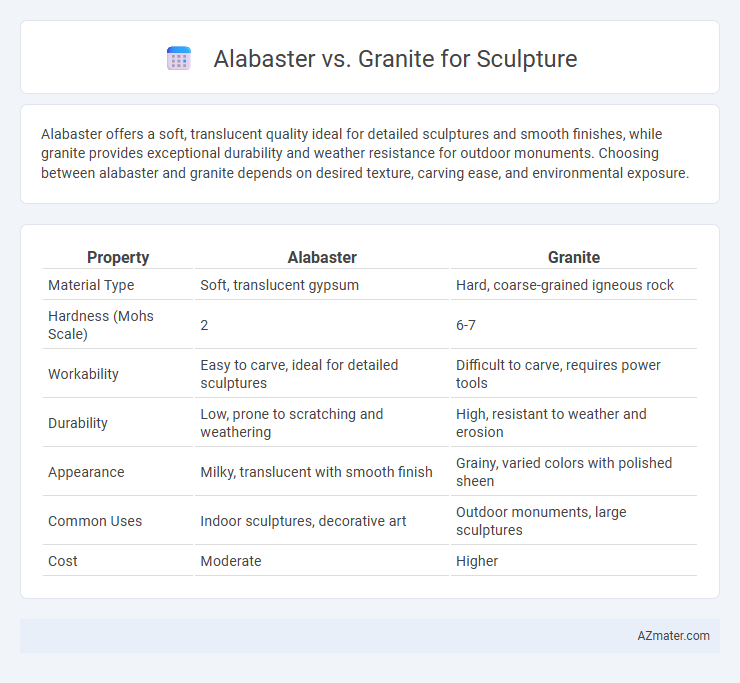Alabaster offers a soft, translucent quality ideal for detailed sculptures and smooth finishes, while granite provides exceptional durability and weather resistance for outdoor monuments. Choosing between alabaster and granite depends on desired texture, carving ease, and environmental exposure.
Table of Comparison
| Property | Alabaster | Granite |
|---|---|---|
| Material Type | Soft, translucent gypsum | Hard, coarse-grained igneous rock |
| Hardness (Mohs Scale) | 2 | 6-7 |
| Workability | Easy to carve, ideal for detailed sculptures | Difficult to carve, requires power tools |
| Durability | Low, prone to scratching and weathering | High, resistant to weather and erosion |
| Appearance | Milky, translucent with smooth finish | Grainy, varied colors with polished sheen |
| Common Uses | Indoor sculptures, decorative art | Outdoor monuments, large sculptures |
| Cost | Moderate | Higher |
Introduction to Alabaster and Granite
Alabaster is a soft, translucent stone composed primarily of gypsum, prized for its smooth texture and ease of carving, making it ideal for detailed sculptures and delicate finishes. Granite, a hard, durable igneous rock composed mainly of quartz, feldspar, and mica, offers exceptional strength and weather resistance, suited for large-scale, outdoor sculptures requiring longevity. The choice between alabaster and granite depends on the desired durability, detail, and setting of the sculpture.
Historical Use in Sculpture
Alabaster has been favored in sculpture since ancient Egypt for its softness and translucency, allowing detailed carvings and a luminous finish ideal for intricate artworks. Granite, used extensively in ancient Egyptian and Roman monuments, is valued for its durability and strength, enabling the creation of monumental statues that withstand weathering. Historical use highlights alabaster's role in delicate indoor sculptures, while granite's enduring presence is prominent in outdoor and large-scale architectural sculptures.
Physical Properties Comparison
Alabaster is a soft, translucent stone with a Mohs hardness of 2 to 3, making it easier to carve and ideal for intricate sculptures requiring fine detail. Granite, with a Mohs hardness of 6 to 7, is much denser and more durable, but its toughness demands specialized tools and extended carving time, resulting in less intricate designs. Both materials exhibit unique grain structures, with alabaster's smooth, uniform texture allowing for delicate finishes, while granite's coarse, granular composition provides long-lasting resilience against weathering.
Workability for Artists
Alabaster offers superior workability for artists due to its softness and fine grain, allowing for intricate detailing and smooth finishes with ease. Granite, although extremely durable and visually striking, poses significant challenges in carving because of its hardness and coarse texture, requiring specialized tools and techniques. Artists seeking precision and delicate features often prefer alabaster for sculpture projects demanding high workability.
Aesthetic Qualities and Appearance
Alabaster offers a smooth, translucent surface with warm, creamy tones that capture light softly, making it ideal for detailed, delicate sculptures with a luminous aesthetic. Granite features a coarse-grained texture and a wide range of natural colors, including speckled patterns, providing a robust and visually dynamic appearance suitable for bold, durable artworks. The choice between alabaster and granite hinges on the desired visual effect: alabaster's ethereal glow versus granite's rugged, colorful complexity.
Durability and Longevity
Granite offers superior durability and longevity for sculptures due to its hardness and resistance to weathering, making it ideal for outdoor artwork exposed to environmental elements. Alabaster, being a softer and more porous stone, is more susceptible to scratching, chipping, and damage from moisture, which limits its use to indoor sculptures or protected environments. Artists often choose granite for long-lasting, enduring sculptures, while alabaster is favored for detailed interior pieces prioritizing delicate work over durability.
Cost and Accessibility
Alabaster is generally more affordable and easier to source, making it a popular choice for beginner sculptors and those on a budget. Granite, while significantly more expensive, offers exceptional durability and is often used for large-scale, outdoor sculptures that require long-term resistance to weathering. Accessibility to granite can be limited due to the need for specialized tools and equipment, whereas alabaster is more widely available and easier to work with using basic carving tools.
Maintenance and Care
Alabaster requires careful maintenance due to its softness and sensitivity to moisture, necessitating gentle cleaning with a dry or slightly damp cloth and avoidance of harsh chemicals to prevent surface damage. Granite, known for its durability and resistance to weathering, demands less frequent upkeep but benefits from periodic sealing to maintain its polished finish and prevent staining. Both materials require protection from prolonged exposure to extreme environmental conditions to preserve their sculptural integrity.
Popular Sculptures and Artists
Alabaster, favored for its translucency and softness, is prominently used by sculptors like Alberto Giacometti, whose intricate forms showcase the material's delicate texture, while granite, known for its durability and hardness, is exemplified in monumental works by artists such as Henry Moore, demonstrating robust, enduring sculptures. Popular alabaster sculptures often feature fine, detailed carvings that highlight the stone's smooth finish, contrasting with granite's coarse grain that lends itself to bold, larger-than-life public installations. Both materials maintain distinct artistic legacies, with alabaster dominating intimate, detailed pieces and granite defining grand, enduring monuments in art history.
Choosing the Right Stone for Your Sculpture
Choosing the right stone for your sculpture depends on factors like texture, durability, and workability, with alabaster offering a soft, translucent quality ideal for intricate details and indoor pieces. Granite, known for its hardness and weather resistance, suits outdoor sculptures requiring longevity and rugged textures. Understanding the specific characteristics and maintenance needs of alabaster versus granite ensures the best material choice for artistic vision and environmental conditions.

Infographic: Alabaster vs Granite for Sculpture
 azmater.com
azmater.com